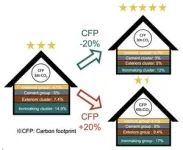(Press-News.org)
Fukuoka, Japan—Researchers at Kyushu University have published a comprehensive analysis on the carbon footprint of constructing a wooden house in Japan. The study covered the total amount of emissions produced, taking into consideration the entire supply chain including the processing and transport of the raw materials that go into building a house.
The team hopes that by identifying emission hot spots in the supply chain that go into building a house, policy makers can implement strategies to reduce its climate impact. Their analysis was published in the Journal of Environmental Management.
As humanity maneuvers itself through the climate crisis, researchers and industry professionals alike have been working to identify sectors with high CO2 emissions so they can implement policies that potentially reduce greenhouse gas production. But in today’s highly interconnected economy, figuring out a sector or object’s greenhouse gas output is astoundingly complex.
“For example, it’s easy to calculate how much CO2 a single automobile will potentially produce. It’s another thing entirely to try and find the totality of emissions a car produces from assembly line to scrap yard. You need to consider the emission that come from the supply chain and manufacturing the raw materials,” explains Professor Shigemi Kagawa from Kyushu University’s Faculty of Economics, whose team has been studying supply chain emissions.
To this end, Kagawa and his team began looking into the combined carbon emissions that come from building a standard wooden house in Japan—which account for approximately 90% of the country’s total housing stock—and which industrial sectors contribute to it the most.
“If you combine the emissions generated by construction activity and the supply chain manufacturing of its essential products it can account for approximately 23% of all global emissions,” explains doctoral candidate Seiya Imada and first author of the study. “94% of that comes from the supply chain alone. Therefore, emission reduction efforts targeting the supply chain is the best way to mitigate any emissions from the construction sector.”
According to the team’s findings, the estimated carbon footprint of building a single wooden house in Japan is 38 tons of CO2. Making up the largest share of that—accounting for 32% of total emissions—was the electric power sector. Other sectors included pig iron production at 12%, with cement, road freight transport, and private power generation each covering 7% of total emissions.
"We also looked into some of the hotspots in the supply chain network. Our analysis found that the steel manufacturing process accounted for the largest share of the carbon footprint, at approximately 15% of total emissions,” continues Imada. “The second highest contributing group was the division involved in material transport and the building materials for a house’s exterior, like bricks. That group accounted for approximately 7.4% of the total carbon footprint.”
The team hopes these new findings can help both industry groups and consumers re-evaluate the carbon footprint of this sector of the construction industry. Some countries have begun to emphasize the importance of constructing ‘low-carbon’ buildings. And while Japan does encourage methods to reduce a home’s total energy use, it still does not have a policy that specifically targets the reduction of CO2 during its building phase.
“Policy makers should promote efforts of renovating and remodeling already existing houses. There should also be a focus on reusing the foundation, which are made with materials from high emission sectors,” Concludes Imada. “The supply chain is very complicated, but if we want to avoid the worst results of the climate crisis, we must be able to understand it and implement policies that reduce emissions effectively.”
###
For more information about this research, see "CO2 emission hotspots analysis on supply chains for wooden houses in Japan," Seiya Imada, Keitaro Maeno, Shigemi Kagawa, Journal of Environmental Management, https://doi.org/10.1016/j.jenvman.2024.120151
About Kyushu University
Founded in 1911, Kyushu University is one of Japan's leading research-oriented institutes of higher education, consistently ranking as one of the top ten Japanese universities in the Times Higher Education World University Rankings and the QS World Rankings. The university is one of the seven national universities in Japan, located in Fukuoka, on the island of Kyushu—the most southwestern of Japan’s four main islands with a population and land size slightly larger than Belgium. Kyushu U’s multiple campuses—home to around 19,000 students and 8000 faculty and staff—are located around Fukuoka City, a coastal metropolis that is frequently ranked among the world's most livable cities and historically known as Japan's gateway to Asia. Through its VISION 2030, Kyushu U will “drive social change with integrative knowledge.” By fusing the spectrum of knowledge, from the humanities and arts to engineering and medical sciences, Kyushu U will strengthen its research in the key areas of decarbonization, medicine and health, and environment and food, to tackle society’s most pressing issues.
END
Scientists at the University of Oregon have discovered that colonies of gelatinous sea animals swim through the ocean in giant corkscrew shapes using coordinated jet propulsion, an unusual kind of locomotion that could inspire new designs for efficient underwater vehicles.
The research involves salps, small creatures that look similar to jellyfish that take a nightly journey from the depths of the ocean to the surface. Observing that migration with special cameras helped UO researchers and their colleagues capture the macroplankton’s graceful, coordinated swimming behavior.
“The largest migration on the planet ...
New research led by Flinders University and international experts is expanding understanding of vaccine-induced immune thrombocytopenia and thrombosis (known as VITT).
At the height of the COVID-19 pandemic in 2021,VITT emerged as a new disease following adenovirus vector-based vaccines – notably the Oxford-AstraZeneca vaccine.
VITT was found to be caused by an unusually dangerous blood autoantibody directed against a protein termed platelet factor 4 (or PF4).
In separate research in 2023, ...
BATON ROUGE – Ochsner Baton Rouge has opened the new Ochsner Outpatient and Home Infusion Pharmacy – Baton Rouge at 4730 Bluebonnet Blvd., Suite 401. This advanced facility provides treatment for chronic, specialty and acute home infusions.
The pharmacy is conveniently located and designed with patient comfort and accessibility in mind. Each of its six patient rooms offers a spa-like environment, providing patient care in a peaceful, supportive setting that promotes healing. Ochsner’s pharmacists work closely with patients’ healthcare providers to create customized treatment plans, ensuring personalized and effective ...
Key takeaways
A new study by UCLA sociologists found that using the word “please” does not always indicate respect or politeness.
In the study, “please” was used only 7% of the time, mostly when there was an inhospitable interactional environment to overcome.
Findings will help researchers in their understanding of politeness in the flow of social behavior and norms.
By kindergarten age, most children have been taught that “please” is a magic word. “Please” is an expression of politeness that shows courtesy and respect, turning a potential demand into a request that will – ...
The Davos Alzheimer’s Collaborative (DAC), the organization leading an unprecedented global response to Alzheimer’s, today announced the first-ever brain health and dementia conference in Africa, held in Nairobi, Kenya from September 11-12 in partnership with Nature Conferences and the Aga Khan University’s Brain & Mind Institute. The conference, “The Future of Dementia in Africa: Advancing Global Partnerships,” focuses on scientific advancements in understanding the impact of dementia, risk ...
Climate change, and its effects on weather patterns and adverse weather events, is likely to negatively affect the health of people with brain conditions, argue a UCL-led team of researchers.
In a Personal View article, published in The Lancet Neurology, the team emphasise the urgent need to understand the impact of climate change on people with neurological conditions – in order to preserve their health and prevent worsening inequalities.
Following a review of 332 papers published across the world between 1968 and 2023, the team, led by Professor Sanjay Sisodiya (UCL Queen Square Institute of Neurology), said they expect the scale of the potential ...
Updated medical guidance on excited delirium, the controversial term accused of covering up deaths in police custody, including that of George Floyd, is being brought forward before its scheduled date of October 2025, reports The BMJ today.
The move comes as attitudes towards the use of the term appear to be changing, explains journalist Chris Stokel-Walker. For instance, last month Colorado joined California in banning police, medical staff and coroners from using the term, and the UK Independent ...
The human papillomavirus (HPV) vaccination programme in England has not only been associated with a substantial reduction in cervical disease, but has done so in all socioeconomic groups, finds a study published by The BMJ today.
Although women living in the most deprived areas are still at higher risk of cervical disease than those in less deprived areas, the results show that well planned and executed public health interventions can both improve health and reduce health inequalities.
HPV ...
Strict embargo: 23.30 hrs BST
Wednesday, 15 May, 2024
Peer-reviewed
Observational
People
The human papillomavirus, or HPV, vaccine is cutting cases of cervical cancer right across the socio-economic spectrum, with most cases being prevented in more deprived groups, according to a major study funded by Cancer Research UK.
Until now, there had been concerns that the HPV vaccine could have an unequal impact across society. After carrying out the longest follow-up on the effectiveness of the HPV vaccine, researchers at Queen Mary University of London concluded the HPV vaccination programme in England is helping to close some inequalities ...
https://doi.org/10.1016/j.apsb.2024.02.015
This new article publication from Acta Pharmaceutica Sinica B, discusses how the use of a radiation-based immunogenic vaccine combined with a macrophage “checkpoint inhibitor” can boost innate and adaptive immunity against metastatic colon cancers.
Immunogenic dying tumor cells hold promising prospects as cancer vaccines to activate systemic immunity against both primary and metastatic tumors. Especially, X-ray- induced dying tumor cells are rich in highly immunogenic tumor-associated antigens ...



